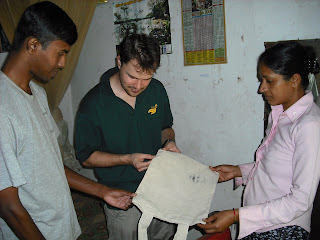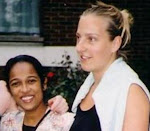Last week, I was very lucky to be able to experience Sri Lankan New Year in the traditional way amongst Kanchana’s family.
One of the best things about my stay has been having the opportunity to encounter many parts of Sri Lankan living from within, in ways that Tourists often don’t. New Year was one of the highlights of these times.
The two day public holiday begins on the 13th April, New Year’s Eve. Kanchana had invited all the neighbours in the surrounding area to come and begin celebrations with a children’s party complete with games and prizes.
Some of these were familiar to me, since they were very similar to game played in England when I was a child. For example, the game to draw an eye on an elephant whilst wearing a blindfold was very like “Pin the Tail on the Donkey”. I have included a few photos below, and a short clip of one of the games features on the YouTube clip on the right hand side.
The Mum's got in on the fun, too!










 Children and parents alike seemed to have a great time, and I enjoyed myself immensely as spectator, photographer, and prize giver!
Children and parents alike seemed to have a great time, and I enjoyed myself immensely as spectator, photographer, and prize giver!On New Year’s Day, it was a very early start. The astrologers had determined that the auspicious time for beginning to boil the coconut milk was at 5.05am, with the time for gifts and eating at 5.50am. The completion of the cooking the milk (which is used to make the milk rice - the traditional New Year food) is when it boils over from it’s clay pot (which is traditionally new). It was important that this happened in time to prepare the food for 5.50am - so when it reached boiling it was welcomed as a sign of prosperity for the New Year.

The breakfast of the delicious milk rice was served with a number of traditional New Year sweet items. It was a real honour to be part of this important and cherished tradition, and I was particularly touched to receive a gift of a lovely new shirt.
New Year is a time of worshipping the elders, and gift giving is accompanied by bowing to the ground before the elder gift recipient.
We then left for the 2 hour journey to Kuliyapitiya, the small town where both Kanchana’s and Thushara’s families live. On the way, the boys, Buhusuru and Nipuna set about teaching me how to say Happy New Year in Sinhala: “Suba Aluth Awuruddak Wewa!” It didn’t exactly roll off my tongue initially, but I eventually got the hang of it - sort of.
It was a great couple of days, yet tiring for all!


The breakfast of the delicious milk rice was served with a number of traditional New Year sweet items. It was a real honour to be part of this important and cherished tradition, and I was particularly touched to receive a gift of a lovely new shirt.
New Year is a time of worshipping the elders, and gift giving is accompanied by bowing to the ground before the elder gift recipient.
We then left for the 2 hour journey to Kuliyapitiya, the small town where both Kanchana’s and Thushara’s families live. On the way, the boys, Buhusuru and Nipuna set about teaching me how to say Happy New Year in Sinhala: “Suba Aluth Awuruddak Wewa!” It didn’t exactly roll off my tongue initially, but I eventually got the hang of it - sort of.

Once at Kuliyapitiya, it was a busy time of moving from home to home visiting relatives and giving worship to elders - with the offering of Betel leaves. Everywhere we went, there was also LOTS of delicious food on offer.
In many ways, the day was uniquely Sri Lankan - with an adherence to tradition that was very noticeable to my British eyes. Yet in other ways it was reassuringly familiar: gifts, continuous eating, and most importantly spending time with family - it could almost have been Christmas day.
Above is a picture of me with members of Thusara’s family.
Like so many elements of my time in Sri Lanka, I was aware of how the details may change, but fundamentally humans are the same the world over.
Like so many elements of my time in Sri Lanka, I was aware of how the details may change, but fundamentally humans are the same the world over.
It was a great couple of days, yet tiring for all!


















